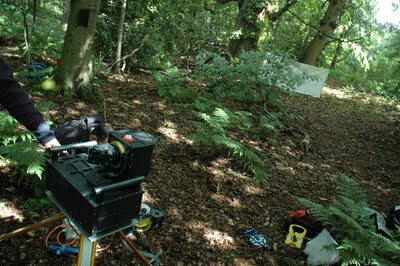In the morning, we completed an experiment that Richard Casey has put forward, which involves placing a sheet of material with a known reflectance a distance behind leafy and woody material at plot 12, a mixed deciduous plot. This area was then scanned at high resolution using both wavelengths. When the results have been processed, we will be able to isolate intensities that have come from 100% leaf hits and 100% wood hits. Under the assumption that the reflectance of leafy and woody material does not vary, the intensities collected could give us information on what material the beam has hit and by introducing a linear scale, intensity values can show us the proportion of the beam that the target has covered, which will potentially increase the precision of our gap fraction analysis results.
 |
| Blanket experiment at plot 12 |
One of our hopes was to use a Reigl 210 scanner to compare our SALCA scan results at each of the plots. However, there has been a technical issue with the Reigl and despite our best efforts, we have not been able to overcome these in the field. We do aim to take the 210 out at some point in the near future, as the data we will collect will be useful in linking this work with previous research conducted by Alberto and Vishal.
 |
| Mark and Turkia collecting spectral refectances of leafy and woody material using the ASD |
In addition to further manual field measurements completed in plot 4, our second scan is completed in an open beech plot (plot 15). This stand has large, old trees and is ideal for a range calibration experiment. As we have not tested how laser intensity changes with range, we place calibration cards with a known reflectance on 8 trees at increasing distances from SALCA. We will be able to compare the results from the intensities of these cards against a theoretical loss of power (1/range squared).
 |
| Oliver explaining the operation of SALCA to Richard Mostyn form the Forestry Commission |
During setup at plot 15, there is a chance encounter with several members of the Forestry Commission. This proves to be a great opportunity for an impromptu demonstration of SALCA and the chance to explain how our research fits into future forest monitoring and management strategies. We also use this as a chance to highlight the benefits of an off-road pram for intensive forestry fieldwork.
Oliver Gunawan
6th July 2011


No comments:
Post a Comment